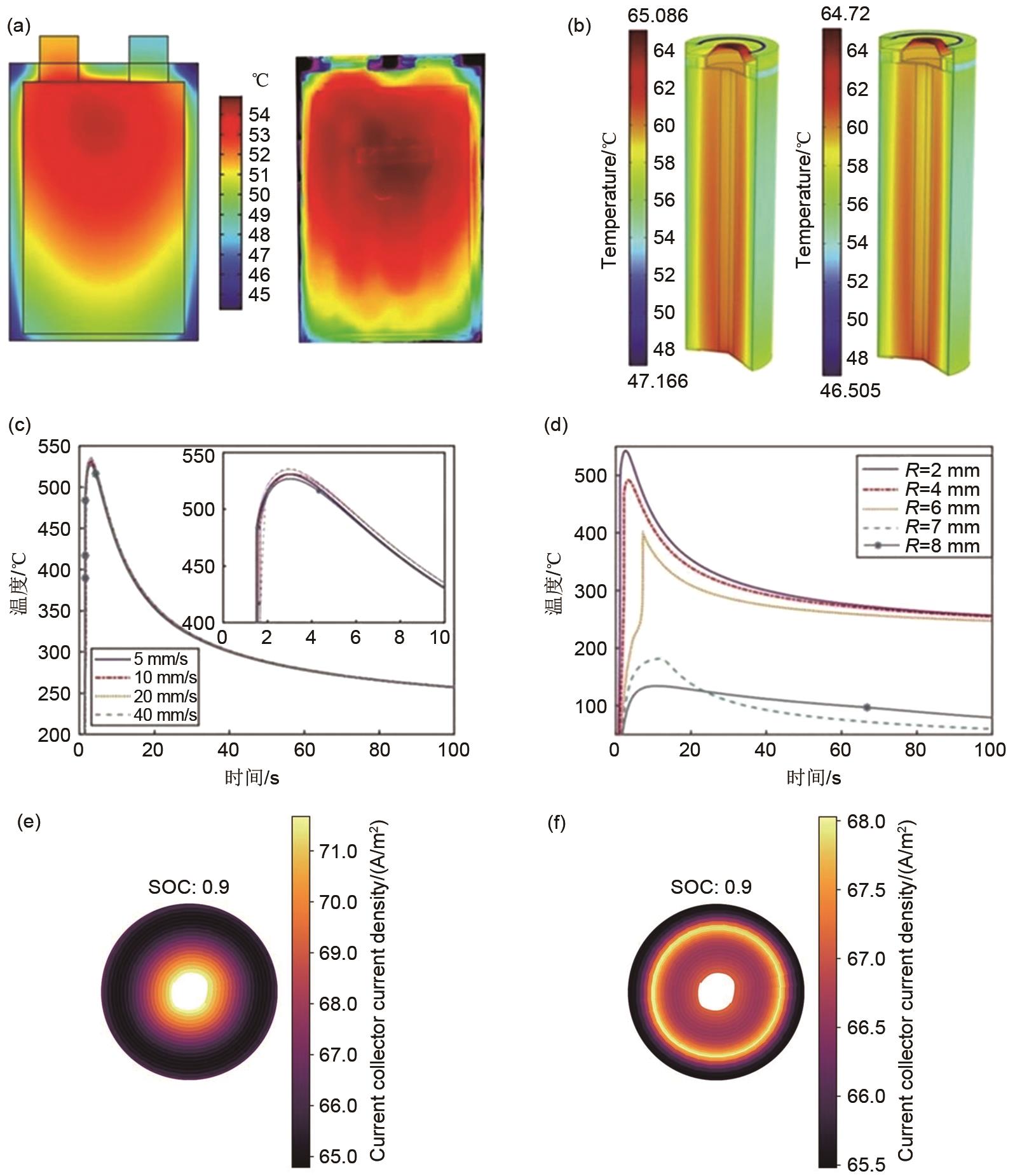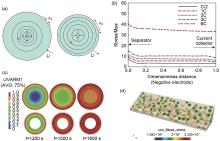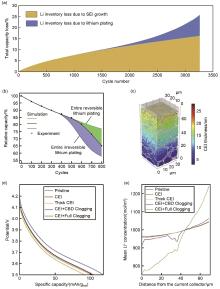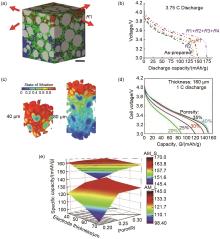Energy Storage Science and Technology ›› 2023, Vol. 12 ›› Issue (7): 2302-2318.doi: 10.19799/j.cnki.2095-4239.2023.0296
Previous Articles Next Articles
Wenda ZAN( ), Rui ZHANG, Fei DING(
), Rui ZHANG, Fei DING( )
)
Received:2023-05-04
Revised:2023-05-17
Online:2023-07-05
Published:2023-07-25
Contact:
Fei DING
E-mail:1280196469@qq.com;hilldingfei@163.com
CLC Number:
Wenda ZAN, Rui ZHANG, Fei DING. Development and application of electrochemical models for lithium-ion batteries[J]. Energy Storage Science and Technology, 2023, 12(7): 2302-2318.

Fig. 6
(a) 2D temperature distribution of flexible battery at the end of discharge at 5 ℃, simulation (left) and experiment (right); (b) 3D simulation of the temperature distribution inside the cylindrical battery at the end of charging (left) and discharging (right) at 5 ℃; (c) The effect of different needle speed on thermal runaway of batteries; (d) The effect of different needle diameters on thermal runaway of batteries; (e) Current density distribution of 18650 battery under single pole lug setting; (f) Current density distribution of 18650 battery in bipolar lug setting"


Fig. 7
(a) Schematic diagram of particle expansion (left) and contraction (right) during lithiation and delithiation processes; (b) The stress on the surface of particles of anodes at the end of discharge with different rates; (c) Lithium concentration distribution of carbon coated particles and hollow spherical particles during lithification; (d) Lithium ion concentration distribution in cathode particles with mesoscale model"


Fig. 8
(a) The loss of capacity caused by SEI formation (brown area) and lithium plating (blue area) during long-term cycling; (b) Nonlinear loss of capacity during long-term cycling; (c) The three-dimensional reconstruction model of NCM cathode with CEI film; (d) The variation of electric potential along the thickness direction with different thicknesses of CEI film and blockage degrees; (e) The variation of lithium ion concentration along the thickness direction with different thicknesses of CEI film and blockage degrees"


Fig. 13
(a) Morphological control of three-dimensional reconstruction models; (b) Discharge simulation of three-dimensional reconstruction models with adjusted porosity; (c)-(d) Discharge simulation of reconstruction models with different thicknesses; (e) The effects of porosity and electrode thickness on capacity"

| 1 | NITTA N, WU F X, LEE J T, et al. Li-ion battery materials: Present and future[J]. Materials Today, 2015, 18(5): 252-264. |
| 2 | KIM T, SONG W T, SON D Y, et al. Lithium-ion batteries: Outlook on present, future, and hybridized technologies[J]. Journal of Materials Chemistry A, 2019, 7(7): 2942-2964. |
| 3 | NEJAD S, GLADWIN D T, STONE D A. A systematic review of lumped-parameter equivalent circuit models for real-time estimation of lithium-ion battery states[J]. Journal of Power Sources, 2016, 316: 183-196. |
| 4 | MENG J H, LUO G Z, RICCO M, et al. Overview of lithium-ion battery modeling methods for state-of-charge estimation in electrical vehicles[J]. Applied Sciences, 2018, 8(5): 659. |
| 5 | BERGVELD H J, KRUIJT W S, NOTTEN P H L. Electronic-network modelling of rechargeable NiCd cells and its application to the design of battery management systems[J]. Journal of Power Sources, 1999, 77(2): 143-158. |
| 6 | DOYLE M, NEWMAN J, GOZDZ A S, et al. Comparison of modeling predictions with experimental data from plastic lithium ion cells[J]. Journal of the Electrochemical Society, 1996, 143(6): 1890-1903. |
| 7 | 杨东辉, 吴贤章, 王羽平, 等. 锂离子电池电化学仿真技术综述[J]. 储能科学与技术, 2021, 10(3): 1060-1070. |
| YANG D H, WU X Z, WANG Y P, et al. Overview of electrochemical simulation technology for lithium ion batteries[J]. Energy Storage Science and Technology, 2021, 10(3): 1060-1070. | |
| 8 | 杨杰, 王婷, 杜春雨, 等. 锂离子电池模型研究综述[J]. 储能科学与技术, 2019, 8(1): 58-64. |
| YANG J, WANG T, DU C Y, et al. Overview of the modeling of lithium-ion batteries[J]. Energy Storage Science and Technology, 2019, 8(1): 58-64. | |
| 9 | 程昀, 李劼, 贾明, 等. 锂离子电池多尺度数值模型的应用现状及发展前景[J]. 物理学报, 2015, 64(21): 145-160. |
| CHENG Y, LI J, JIA M, et al. Application status and future of multi-scale numerical models for lithium ion battery[J]. Acta Physica Sinica, 2015, 64(21): 145-160. | |
| 10 | EULER J, NONNENMACHER W. Stromverteilung in porösen elektroden[J]. Electrochimica Acta, 1960, 2(4): 268-286. |
| 11 | NEWMAN J S, TOBIAS C W. Theoretical analysis of current distribution in porous electrodes[J]. Journal of the Electrochemical Society, 1962, 109(12): 1183. |
| 12 | NEWMAN J, CHAPMAN T W. Restricted diffusion in binary solutions[J]. AIChE Journal, 1973, 19(2): 343-348. |
| 13 | NEWMAN J, TIEDEMANN W. Porous-electrode theory with battery applications[J]. AIChE Journal, 1975, 21(1): 25-41. |
| 14 | CHEN Z Q, DANILOV D L, EICHEL R A, et al. Porous electrode modeling and its applications to Li-ion batteries[J]. Advanced Energy Materials, 2022, 12(32): doi: 10.1002/aenm.202201506. |
| 15 | DU S L, LAI Y Q, AI L, et al. An investigation of irreversible heat generation in lithium ion batteries based on a thermo-electrochemical coupling method[J]. Applied Thermal Engineering, 2017, 121: 501-510. |
| 16 | ZHANG X C, SHYY W, MARIE SASTRY A. Numerical simulation of intercalation-induced stress in Li-ion battery electrode particles[J]. Journal of the Electrochemical Society, 2007, 154(10): A910. |
| 17 | 邵素霞, 朱振东, 彭文. 锂离子电池电极材料反应速率常数研究[J]. 电池工业, 2020, 24(4): 179-183. |
| SHAO S X, ZHU Z D, PENG W. The study on reaction rate constant of electrode materials in lithium ion batteries[J]. Chinese Battery Industry, 2020, 24(4): 179-183. | |
| 18 | 马克华. 锂离子电池参数获取及变参数模型[D]. 哈尔滨: 哈尔滨工业大学. |
| MA K H. Parameter acquisition and variable parameter model of lithium ion battery[D]. Harbin: Harbin Institute of Technology. | |
| 19 | 邵素霞, 朱振东, 王蓉蓉, 等. 三种方法测定电极材料的扩散系数[J]. 电池, 2021, 51(6): 577-581. |
| SHAO S X, ZHU Z D, WANG R R, et al. Characterizing diffusion coefficient of electrode materials by three methods[J]. Battery Bimonthly, 2021, 51(6): 577-581. | |
| 20 | JIANG F M, PENG P. Elucidating the performance limitations of lithium-ion batteries due to species and charge transport through five characteristic parameters[J]. Scientific Reports, 2016, 6: doi: 10.1038/srep32639. |
| 21 | MALIFARGE S, DELOBEL B, DELACOURT C. Experimental and modeling analysis of graphite electrodes with various thicknesses and porosities for high-energy-density Li-ion batteries[J]. Journal of the Electrochemical Society, 2018, 165(7): A1275-A1287. |
| 22 | COLCLASURE A M, TANIM T R, JANSEN A N, et al. Electrode scale and electrolyte transport effects on extreme fast charging of lithium-ion cells[J]. Electrochimica Acta, 2020, 337: doi: 10.1016/j.electacta.2020.135854. |
| 23 | XU M, REICHMAN B, WANG X. Modeling the effect of electrode thickness on the performance of lithium-ion batteries with experimental validation[J]. Energy, 2019, 186: doi: 10.1016/j.energy.2019.115864. |
| 24 | GOUTAM S, NIKOLIAN A, JAGUEMONT J, et al. Three-dimensional electro-thermal model of li-ion pouch cell: Analysis and comparison of cell design factors and model assumptions[J]. Applied Thermal Engineering, 2017, 126: 796-808. |
| 25 | SAW L H, YE Y H, TAY A A O. Electrochemical-thermal analysis of 18650 Lithium Iron Phosphate cell[J]. Energy Conversion and Management, 2013, 75: 162-174. |
| 26 | LIN N, RÖDER F, KREWER U. Multiphysics modeling for detailed analysis of multi-layer lithium-ion pouch cells[J]. Energies, 2018, 11(11): 2998. |
| 27 | MEI W X, LIANG C, SUN J H, et al. Three-dimensional layered electrochemical-thermal model for a lithium-ion pouch cell[J]. International Journal of Energy Research, 2020, 44(11): 8919-8935. |
| 28 | TRANTER T G, TIMMS R, HEENAN T M M, et al. Probing heterogeneity in Li-ion batteries with coupled multiscale models of electrochemistry and thermal transport using tomographic domains[J]. Journal of the Electrochemical Society, 2020, 167(11): doi: 10.1149/1945-7111/aba44b. |
| 29 | 胡力月, 姚行艳. 基于正交试验的锂离子电池热失控仿真[J]. 储能科学与技术, 2023, 12(4): 1268-1277. |
| HU L Y, YAO X Y. Thermal runaway of lithium-ion batteries based on orthogonal test[J]. Energy Storage Science and Technology, 2023, 12(4): 1268-1277. | |
| 30 | KIM G H, PESARAN A, SPOTNITZ R. A three-dimensional thermal abuse model for lithium-ion cells[J]. Journal of Power Sources, 2007, 170(2): 476-489. |
| 31 | FENG X N, LU L G, OUYANG M G, et al. A 3D thermal runaway propagation model for a large format lithium ion battery module[J]. Energy, 2016, 115: 194-208. |
| 32 | CHRISTENSEN J, NEWMAN J. Stress generation and fracture in lithium insertion materials[J]. Journal of Solid State Electrochemistry, 2006, 10(5): 293-319. |
| 33 | RENGANATHAN S, SIKHA G, SANTHANAGOPALAN S, et al. Theoretical analysis of stresses in a lithium ion cell[J]. Journal of the Electrochemical Society, 2010, 157(2): A155. |
| 34 | SUN F N, FENG L, BU J H, et al. Effect of stress on electrochemical performance of hollow carbon-coated silicon snode in lithium ion batteries[J]. Acta Physica Sinica, 2019, 68(12): 120201. |
| 35 | MAI W J, YANG M, SOGHRATI S. A particle-resolved 3D finite element model to study the effect of cathode microstructure on the behavior of lithium ion batteries[J]. Electrochimica Acta, 2019, 294: 192-209. |
| 36 | BIRKL C R, ROBERTS M R, MCTURK E, et al. Degradation diagnostics for lithium ion cells[J]. Journal of Power Sources, 2017, 341: 373-386. |
| 37 | PASTOR-FERNÁNDEZ C, UDDIN K, CHOUCHELAMANE G H, et al. A comparison between electrochemical impedance spectroscopy and incremental capacity-differential voltage as Li-ion diagnostic techniques to identify and quantify the effects of degradation modes within battery management systems[J]. Journal of Power Sources, 2017, 360: 301-318. |
| 38 | YANG X G, LENG Y J, ZHANG G S, et al. Modeling of lithium plating induced aging of lithium-ion batteries: Transition from linear to nonlinear aging[J]. Journal of Power Sources, 2017, 360: 28-40. |
| 39 | NAUMANN M, SPINGLER F B, JOSSEN A. Analysis and modeling of cycle aging of a commercial LiFePO4/graphite cell[J]. Journal of Power Sources, 2020, 451: doi: 10.1016/j.jpowsour.2019.227666. |
| 40 | KEIL J, JOSSEN A. Electrochemical modeling of linear and nonlinear aging of lithium-ion cells[J]. Journal of the Electrochemical Society, 2020, 167(11): doi: 10.1149/1945-7111/aba44f. |
| 41 | ZHANG M H, CHOUCHANE M, ALI SHOJAEE S, et al. Coupling of multiscale imaging analysis and computational modeling for understanding thick cathode degradation mechanisms[J]. Joule, 2023, 7(1): 201-220. |
| 42 | KINDERMANN F M, KEIL J, FRANK A, et al. A SEI modeling approach distinguishing between capacity and power fade[J]. Journal of the Electrochemical Society, 2017, 164(12): E287-E294. |
| 43 | XU R, YANG Y, YIN F, et al. Heterogeneous damage in Li-ion batteries: Experimental analysis and theoretical modeling[J]. Journal of the Mechanics and Physics of Solids, 2019, 129: 160-183. |
| 44 | LIU P F, XU R, LIU Y J, et al. Computational modeling of heterogeneity of stress, charge, and cyclic damage in composite electrodes of Li-ion batteries[J]. Journal of the Electrochemical Society, 2020, 167(4): doi: 10.1149/1945-7111/ab78fa. |
| 45 | BOYCE A M, MARTÍNEZ-PAÑEDA E, WADE A, et al. Cracking predictions of lithium-ion battery electrodes by X-ray computed tomography and modelling[J]. Journal of Power Sources, 2022, 526: doi: 10.1016/j.jpowsour.2022.231119. |
| 46 | CHOUCHANE M, FRANCO A A. Deconvoluting the impacts of the active material skeleton and the inactive phase morphology on the performance of lithium ion battery electrodes[J]. Energy Storage Materials, 2022, 47: 649-655. |
| 47 | LIU C Y, LOMBARDO T, XU J H, et al. An experimentally-validated 3D electrochemical model revealing electrode manufacturing parameters' effects on battery performance[J]. Energy Storage Materials, 2023, 54: 156-163. |
| 48 | BOYCE A M, LU X K, BRETT D J L, et al. Exploring the influence of porosity and thickness on lithium-ion battery electrodes using an image-based model[J]. Journal of Power Sources, 2022, 542: doi: 10.1016/j.jpowsour.2022.231779. |
| 49 | LOMBARDO T, NGANDJONG A C, BELHCEN A, et al. Carbon-binder migration: A three-dimensional drying model for lithium-ion battery electrodes[J]. Energy Storage Materials, 2021, 43: 337-347. |
| 50 | NGANDJONG A C, LOMBARDO T, PRIMO E N, et al. Investigating electrode calendering and its impact on electrochemical performance by means of a new discrete element method model: Towards a digital twin of Li-Ion battery manufacturing[J]. Journal of Power Sources, 2021, 485: doi: 10.1016/j.jpowsour.2020.229320. |
| 51 | LU X K, BERTEI A, FINEGAN D P, et al. 3D microstructure design of lithium-ion battery electrodes assisted by X-ray nano-computed tomography and modelling[J]. Nature Communications, 2020, 11: 2079. |
| 52 | LU X K, DAEMI S R, BERTEI A, et al. Microstructural evolution of battery electrodes during calendering[J]. Joule, 2020, 4(12): 2746-2768. |
| 53 | DI DOMENICO D, STEFANOPOULOU A, FIENGO G. Lithium-ion battery state of charge and critical surface charge estimation using an electrochemical model-based extended Kalman filter[J]. Journal of Dynamic Systems, Measurement, and Control, 2010, 132(6): 1. |
| 54 | LI W H, FAN Y, RINGBECK F, et al. Electrochemical model-based state estimation for lithium-ion batteries with adaptive unscented Kalman filter[J]. Journal of Power Sources, 2020, 476: doi: 10.1016/j.jpowsour.2020.228534. |
| 55 | FATHIANNASAB H, GHORBANI KASHKOOLI A, LI T Y, et al. Three-dimensional modeling of all-solid-state lithium-ion batteries using synchrotron transmission X-ray microscopy tomography[J]. Journal of the Electrochemical Society, 2020, 167(10): doi: 10.1149/1945-7111/ab9380. |
| 56 | FATHIANNASAB H, ZHU L K, CHEN Z W. Chemo-mechanical modeling of stress evolution in all-solid-state lithium-ion batteries using synchrotron transmission X-ray microscopy tomography[J]. Journal of Power Sources, 2021, 483: doi: 10.1016/j.jpowsour. 2020.229028. |
| 57 | ZHANG T, MARINESCU M, WALUS S, et al. Modelling transport-limited discharge capacity of lithium-sulfur cells[J]. Electrochimica Acta, 2016, 219: 502-508. |
| [1] | Shuqin LIU, Xiaoyan WANG, Zhendong ZHANG, Zhenxia DUAN. Experimental and simulation research on liquid-cooling system of lithium-ion battery packs [J]. Energy Storage Science and Technology, 2023, 12(7): 2155-2165. |
| [2] | Qingsong ZHANG, Fangwei BAO, Jiangjao NIU. Risk analysis method of thermal runaway gas explosion in lithium-ion batteries [J]. Energy Storage Science and Technology, 2023, 12(7): 2263-2270. |
| [3] | Yubo ZHANG, Youyuan WANG, Dongning HUANG, Ziyi WANG, Weigen CHEN. Prognostic method of lithium-ion battery lifetime degradation under various working conditions [J]. Energy Storage Science and Technology, 2023, 12(7): 2238-2245. |
| [4] | Qinpei CHEN, Xuehui WANG, Wenzhong MI. Experiential study on the toxic and explosive characteristics of thermal runaway gas generated in electric-vehicle lithium-ion battery systems [J]. Energy Storage Science and Technology, 2023, 12(7): 2256-2262. |
| [5] | Hongsheng GUAN, Cheng QIAN, Binghui XU, Bo SUN, Yi REN. SAM-GRU-based fusion neural network for SOC estimation in lithium-ion batteries under a wide range of operating conditions [J]. Energy Storage Science and Technology, 2023, 12(7): 2229-2237. |
| [6] | Maosong FAN, Mengmeng GENG, Guangjin ZHAO, Kai YANG, Fangfang WANG, Hao LIU. Research on battery sorting technology for echelon utilization based on multifrequency impedance [J]. Energy Storage Science and Technology, 2023, 12(7): 2202-2210. |
| [7] | Yi WANG, Xuebing CHEN, Yuanxi WANG, Jieyun ZHENG, Xiaosong LIU, Hong LI. Overview of multilevel failure mechanism and analysis technology of energy storage lithium-ion batteries [J]. Energy Storage Science and Technology, 2023, 12(7): 2079-2094. |
| [8] | Fang LI, Yongjun MIN, Yong ZHANG. Review of key technology research on the reliability of power lithium batteries based on big data [J]. Energy Storage Science and Technology, 2023, 12(6): 1981-1994. |
| [9] | Yuxin CHEN, Jiamu YANG, Dongbo LI, Cheng LIAN, Honglai LIU. Numerical simulation of the vacuum drying process of cylindrical lithium-ion batteries [J]. Energy Storage Science and Technology, 2023, 12(6): 1957-1967. |
| [10] | Birong TAN, Jianhua DU, Xianghu YE, Xin CAO, Chang QU. Overview of SOC estimation methods for lithium-ion batteries based on model [J]. Energy Storage Science and Technology, 2023, 12(6): 1995-2010. |
| [11] | Luhao HAN, Ziyang WANG, Xiaolong HE, Chunshan HE, Xiaolong SHI, Bin YAO. The effect of water mist strategies on thermal runaway fire suppression of large-capacity NCM lithium-ion battery [J]. Energy Storage Science and Technology, 2023, 12(5): 1664-1674. |
| [12] | Jintao LI, Yue MU, Jing WANG, Jingyi QIU, Hai MING. Investigation of the structural evolution and interface behavior in cathode materials for Li-ion batteries [J]. Energy Storage Science and Technology, 2023, 12(5): 1636-1654. |
| [13] | Yongli YI, Ran YU, Wu LI, Yi JIN, Zheren DAI. Preparation of Mo, Al-doped Li7La3Zr2O12-based composite solid electrolyte and performance of all-solid-state batterys [J]. Energy Storage Science and Technology, 2023, 12(5): 1490-1499. |
| [14] | Linze LI, Xiangwen ZHANG. SOH estimation for lithium-ion batteries based on combination of frequency impedance characteristics [J]. Energy Storage Science and Technology, 2023, 12(5): 1705-1712. |
| [15] | Ni YANG, Yuefeng SU, Lian WANG, Ning LI, Liang MA, Chen ZHU. Research progress of focused ion beam microscopy in lithium-ion batteries [J]. Energy Storage Science and Technology, 2023, 12(4): 1283-1294. |
| Viewed | ||||||
|
Full text |
|
|||||
|
Abstract |
|
|||||
